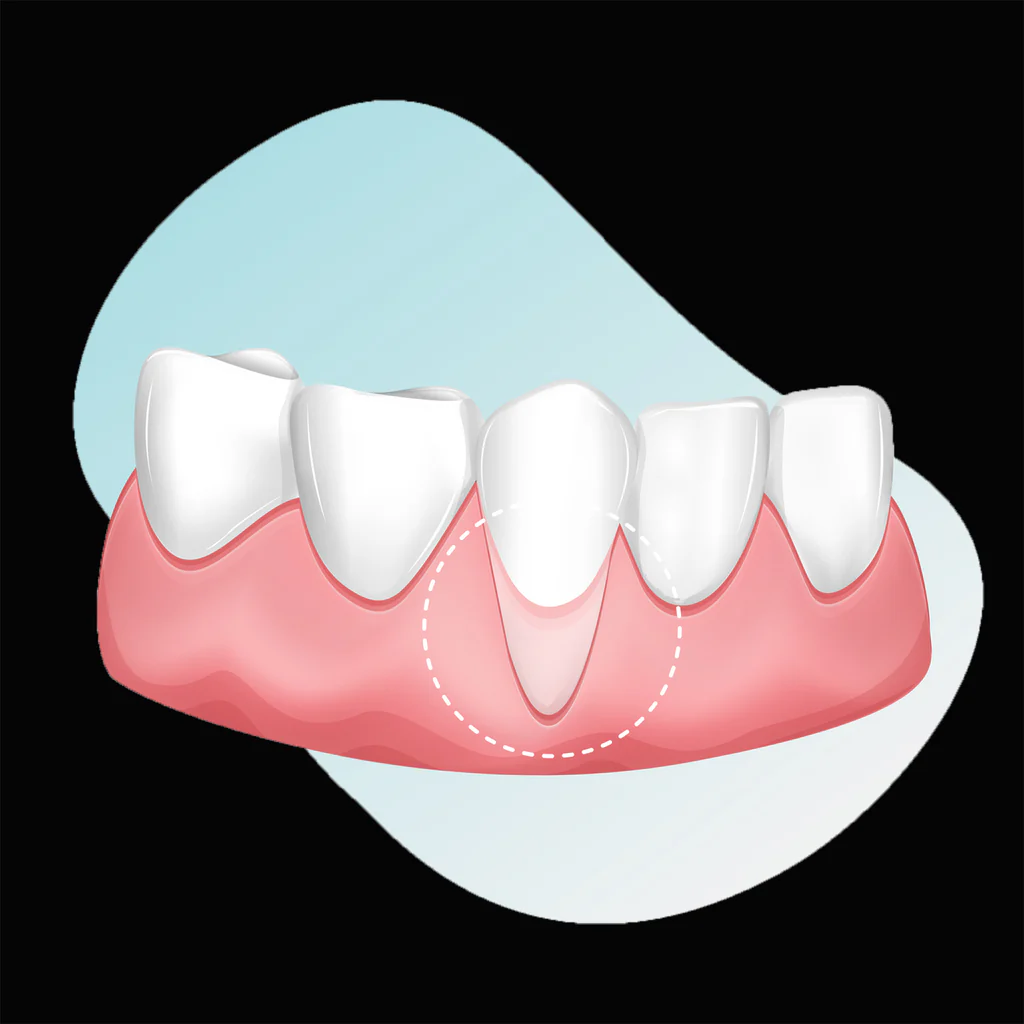Subtotal: ₴ 5 115,00

Receding gums: causes, symptoms, therapy, prevention
Receding gums
Causes, symptoms, treatments, prevention.
In the following I will describe the causes that can lead to receding gums, how they can be largely avoided and how they can be treated with modern methods
Recession of the gums, known as recession, means a loss of gums beyond the crown portion of the tooth. It is a disease of the periodontal ligament and therefore affects not only the gums but also the bone surrounding the teeth. This results in exposed parts of the tooth root.

Causes:
Various factors can play a decisive role in the development of receding gums:
Incorrect brushing technique and overly aggressive cleaning products: if a brushing technique is used incorrectly in a transverse direction (scrubbing) or if brushes and cleaning products that are too hard and aggressive are used, small injuries are repeatedly caused to the gum line. If the gum line continues to be injured, it becomes inflamed, the underlying bone is broken down and the gums recede.
Functional overload (pressing and grinding): Incorrect loading of the teeth often occurs when there are dysfunctions of the jaw joints or when the teeth are misaligned (tilting, rotation of the teeth). Psychological stress such as stress can also lead to grinding or pressing of the teeth, which usually occurs at night. This permanent overload can lead to reduced blood flow to the gums, which can subsequently lead to receding gums.
Lip and cheek frenulum: Lip or cheek frenulum can permanently irritate the gum line by constantly pulling on it. If you pull on the frenulum in question during the examination of the patient and this leads to an anemic reaction (white gum papilla due to bloodlessness), this leads to permanent damage to the gum tissue in everyday life and subsequently to gum recession (recession).
Excessive or incorrect use of force during orthodontic treatment: Forced movement of the teeth can lead to recessions, especially in patients with very narrow bone surrounding the tooth. A large part of the tooth root is moved out of the tooth-bearing bone, which can subsequently lead to gum recession. At the same time, it must be mentioned that orthodontic measures can also positively support the process of recession coverage by returning teeth to the tooth-bearing bone.
Inflammatory or degenerative processes in the gum area (periodontitis and periodontosis): Incipient inflammation of the gums (gingivitis) can heal without subsequent damage if treated early. If treatment is started too late or a disease is detected too late because regular check-ups at the dentist have not taken place, periodontitis can develop. This affects not only the gums but also the bone surrounding the tooth. If the bone then breaks down due to the inflammatory changes, the gums will also recede further and a recession will occur.
Receding gums can be both painful and aesthetically detrimental. If the recession is left untreated, in the worst case scenario it can lead to the loss of the affected teeth.
If treatment is started too late or a disease is detected too late because regular check-ups at the dentist have not taken place, periodontitis can develop.
Symptoms: The most common symptoms of gingival recession are: Exposed tooth necks (teeth that appear longer) Sensitive teeth (pain from heat, cold, sweet and sour foods) Possible loss of gums that are firmly attached to the tooth Possible loss of hard tooth substance in the area of the exposed root surface Therapies: Regardless of the surgical therapy chosen, any existing inflammatory changes must be eliminated prior to any treatment to eliminate gum recession. In addition, incorrect loading of the teeth must be treated and the patient must be shown the correct brushing technique and cleaning products as part of oral hygiene instructions. Furthermore, the patient should be motivated to enter a recall program with regular check-ups tailored to the individual risk of further recessions and inflammations. Various surgical methods adapted to the extent of the recession are available for the treatment of gum recession. Coronary flap (with or without free connective tissue transplant) With this technique, the gums below the recession are moved upwards towards the tooth crown using special surgical procedures and fixed with sutures. This allows the portion of the resulting gum recession to be covered.
In patients with thin gums, this technique can be combined with a free connective tissue transplant. This allows the gums to be thickened and subsequently made more stable against new recessions.
Removal of a free connective tissue transplant The connective tissue is usually removed from the lateral palate. With the help of magnifying glasses or microscopes, a portion of tissue can be removed microsurgically directly below the palatal mucosa. This small procedure allows sufficient connective tissue to be obtained. The wounds then heal mostly without irritation and pain.
Tunnel technique to cover gum recession With this technique, there are no pressure-relieving incisions within the gums. This means that completely scar-free results can be achieved. This technique can also be used to treat several recessions next to each other without any problems.
Put simply, this technique involves preparing a “bag” deep in the gums, starting from the point where the gums are receding. The gum papillae between the individual teeth remain intact. If there are several recessions next to each other, the prepared “bags” can be connected underground in the form of a tunnel. The free connective tissue transplant removed as described above can now be inserted into the space created. The gums are then fixed with fine sutures at the new height covering the recession.
Prevention: what does SNOW PEARL offer?
Because incorrect brushing techniques and overly aggressive cleaning products play a significant role in the development of gum recession, SNOW PEARL has created toothpastes that eliminate this risk factor. The KONEX HD filaments used in all SNOW PEARL toothbrushes are extraordinarily soft and gentle, allowing efficient and thorough cleaning while massaging the gums and promoting healthy blood circulation without causing injury or irritation. The filaments are also very elastic and dimensionally stable, do not bend and are very durable. At their tip they are 8 times thinner than other normal soft filaments, their optimized density allows them to glide deep into the gaps and slightly below the gum line, providing excellent cleaning even there. This combination makes this generation of toothbrushes unbeatable.
 Travel Kit with PEARL SHIELD Gel Toothpaste 75ml - White
Travel Kit with PEARL SHIELD Gel Toothpaste 75ml - White  Travel Kit with SNOW SHINE Whitening Foam 50ml - Black
Travel Kit with SNOW SHINE Whitening Foam 50ml - Black 